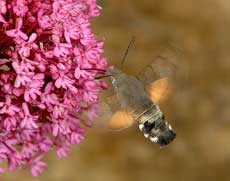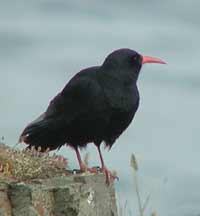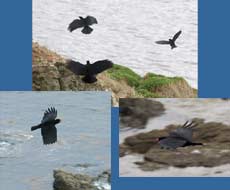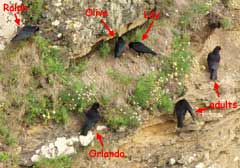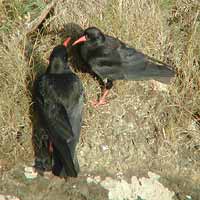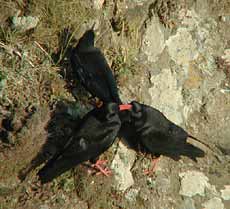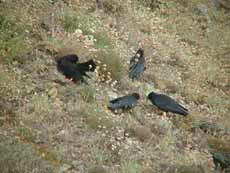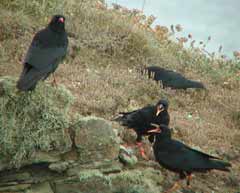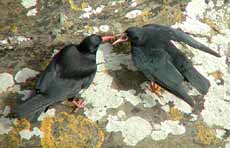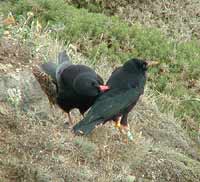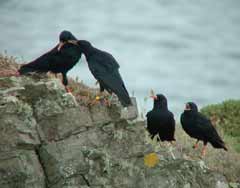Go to last entry on this page.....................Go to previous entry12 June - It's terrible that I haven't updated my garden diary for over a month! After the first week of May, the next two weeks were completely dedicated to the Great Tits. After their chicks had fledged I turned my attention to preparing our caravan and then we headed for our regular hide-away on the Lizard peninsular of Cornwall. We returned last night to a garden that had become a forest of green as the warm weather provided perfect growing conditions - it is almost impossible to see the water in the pond! I have a lot of work to do over the next weeks, before we head back down to Cornwall in late July. Some Holiday Snaps - I spent quite a bit of time using my sit-on-top kayak, but I didn't take any photographs of marine creatures this time. However, I did have the chance to record two very interesting animals on land - a moth and a family of birds.
In the photograph it is feeding at a Red Valarian flower. The plant is a Mediterranean species, which thrives in the mild climate of Cornwall since being introduced here. Click on the images to see larger versions
For the third year in succession the Lizard had seen a pair of wild Choughs nesting (under the 24hr protection of RSPB volunteers). At the end of April bits of shell were seen being removed from the nest inside a cave in the cliffs.
During our holiday the young fledged and I was able to spend several hours, over three evenings watching the family as it provided some spectacular, noisy flying displays and a remarkable degree of bonding between family members. This year they had two male and two female chicks.
In order to study the family in detail the chicks were ringed while still in the nest. The sequence of coloured rings used enables the RSPB to identify each individual. To help remember each bird, they have been given names, each starting with the colours of the two rings on the bird's right leg. I have labelled the youngsters with their first names only but each was given two names as an aid to remember the ring colours. The two males are Orlando Bloom, with orange and black rings on his right leg, and Ralph Richardson, with two red rings. The females are Olive Oil (two orange rings) and Lily Langtry (two lime rings). There are two rings on the left leg - a metal one which has a number on it, and a coloured plastic one, orange for the males and yellow on the females. I have to thank the RSPB member who was on duty at the 'Most Southerly Point' for that information, and also Mike Lord, one of the volunteers who kindly e-mailed me with further details and a few corrections. The organisation had put on a 24hr guard during nesting itself and has volunteers on hand during the daytime to to record the progress of the family as well as help visitors like me - thank you!
The adults have a very close bond and were always together as I watched. On numerous occasions I saw them touching beaks, much as the Great Tits did in the box.
Here, they managed to touch beaks again, before Olive Oil turned round to let them know she was hungry. They are insect eaters, and they would fly off and return together to bring food supplies for their offspring.
On one trip away they left the four young ones on a steep west facing bank, warmed by the evening sunshine. While all four are able to fly, they didn't move for the best part of 30 minutes before the parents returned, spending the time grubbing about the spot in absolute silence.
As they returned the parents announced their arrival with their characteristic loud 'che-oww' call. Once they land they are pestered by the youngsters to regurgitate food. Here, brothers Ralph and Orlando compete for the attention of one of the adults,
and this picture shows one just about to be fed.
Feeding over, its time to do some more bonding, and for the parents to check the plumage of their offspring, presumably for any parasites that might be present. In this case, it is Lily who is receiving attention.
In this picture Ralph is being preened by sister Lily, while Orlando and an adult look on from below.
I don't usually go out looking for birds, but these Choughs have been a real treat for me during our holiday. I will be adding some more images to this page when time permits.... |
|
